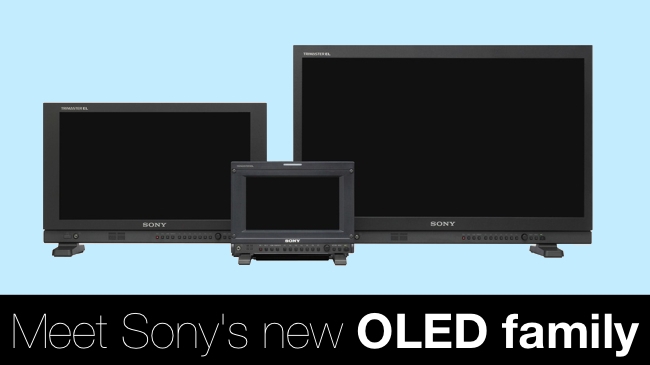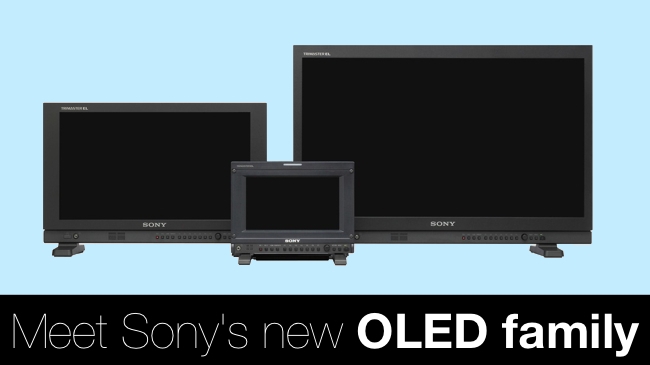
 Sony's new OLED family
Sony's new OLED family
Sony's new range of OLED professional monitors show that the OLED future of TV is getting much closer
In their short history, Sony's OLED monitors and electronic viewfinders have always been things of wonder, beautiful to behold. Even though big 4K screens have dominated the headlines at recent trade shows, there has still been nothing more jaw-dropping than a live feed of Sony's top cinema camera, the F65, displayed on one of its OLED monitors. Even at "mere" HD resolution, nothing can approach the black levels of an OLED screen, and no picture has ever looked so luscious, and yet so subtle.
Recently, Sony announced new OLED models, the PVM-A250, 25” and PVM-A170, 17”, which, in addition to even higher colour accuracy, contrast and overal picture quality, are much lighter - which, when you consider that a large broadcast truck might have fifty of them, means a very significant weight saving and much lower fuel bills.
Power consumption by the new models is lower as well.
We think we can see an important trend here. At first, almost all of Sony's OLED products were virtually hand-made. They were produced in low quantities, largely because they were new and relatively expensive compared to conventional LCD monitors.
Now, with the new monitors being around 40% shallower and lighter, we can see that this type of display is approaching an era of mass-production; not in the same way as a consumer TV, but with a definite sense that this is becoming an established technology.
We've waited a long time for OLED displays, and it looks like we're getting there, at last.
Read Sony's full press release after the break.
Basingstoke, UK, Nov. 12th, 2013: Sony’s newest professional OLED monitors combine lightweight, slim and easily portable designs with the technology’s proven features of high colour accuracy, contrast and picture quality. The new models (PVM-A250, 25” and PVM-A170, 17”) achieved approximately 40% reductions (*2) in depth and weight compared to previous Sony models, delivering more flexibility and ease of use for live program production and broadcast truck applications.
To achieve the new monitors’ decreased weight and depth, Sony re-engineered their entire design, from the chassis to the OLED panel module’s structure to the signal processing board, material and parts. The result is savings in space and logistics expenses, especially important in the tight confines of a broadcast truck. For example, if 50 of the new monitors were loaded on a conventional truck, total weight is reduced by about 180 kg. Power consumption is also reduced by 9% in the PVM-A250 and 14% in the PVM-A170 monitor compared to previous Sony models.
“Higher resolution content creation – 4K and beyond – requires monitors with larger screen sizes for accurate colour evaluation on site,” said Daniel Dubreuil, senior product marketing manager, professional monitors, Sony Europe. “But bigger monitors are harder to carry and take up more space. These new models have the screen size needed for critical evaluation, with a thinner and lighter design that’s perfect for live broadcast and outdoor shooting. They even have a handle for easy carrying.”
Durability is also important for field monitors, to guard against shipping damage and the rigours of on-location use. Protecting the new monitors’ panel, connectors and cabinet is a unique body design and an optional panel protection kit with corner bumpers. This kit can also help maintain high image quality by reducing outside light reflection.
Other operational improvements over previous models include an I/P conversion system that delivers automatically optimized signal processing according to input signals, with low latency (less than 0.5 field). Users can also upgrade the monitors via ethernet cable.
Sony’s unique OLED panel uses its Super Top Emission technology for high light efficiency, high colour purity, high contrast and high reliability. The new models also achieve the industry leading wide viewing angles, enabling group monitoring by video engineers or colourists and improving overall productivity and workflow efficiency.
Sony’s professional TRIMASTER EL™ OLED monitor line has expanded from master monitors to picture monitors since its first launch in 2011. The TRIMASTER EL technology and Sony’s uniquely developed OLED panel superbly reproduces accurate blacks and colours, and features exceptional dynamic range and outstanding motion response to enable the most accurate picture evaluation in the industry.
Sony's TRIMASTER EL monitors have been well received by critical users who demand professional-quality picture performance, resulting in total global shipments of more than 25,000 units to date(*3).
Visitors to the SATIS exhibition in Paris will get the chance to see the PVM-A170 and PVM-A250 for the first time in Europe. The event will take place between 19-21 November, with Sony exhibiting at stand 19, Halle Freyssinet.
The new monitors will be available in January, 2014. For more information please visit www.pro.sony.eu
Notes:
As AC built-in broadcast and professional monitors with HD-SDI input/output, as of Nov. 2013, Sony investigation.
PVM-A250 reduces the depth by 40% and the weight by 42%, PVM-A170 reduces the depth by 45% and the weight by 41% compared with previous Sony models.
As of September 2013.
Tags: Studio & Broadcast


Comments